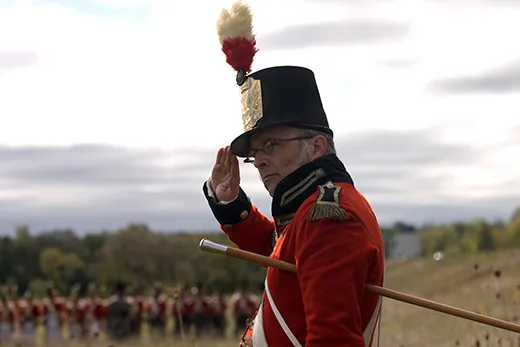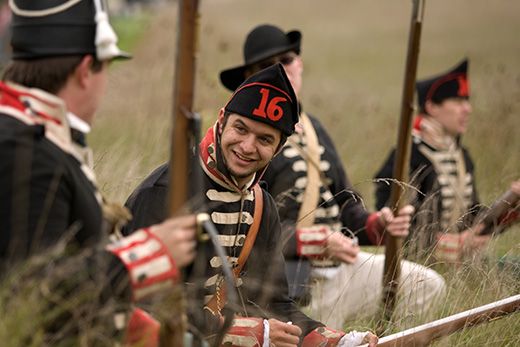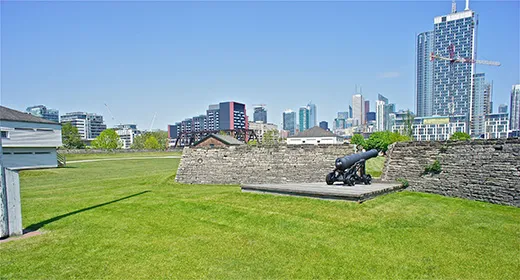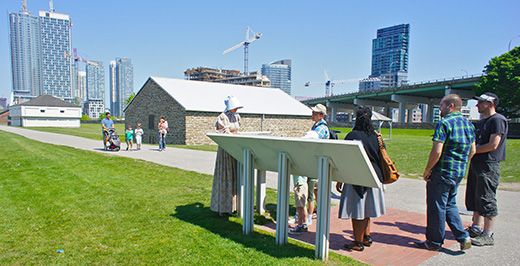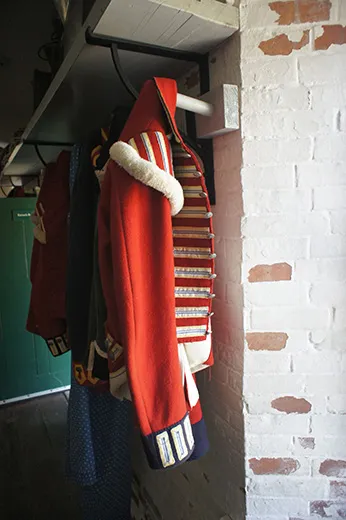How Canada Celebrates the War of 1812
The Rodney Dangerfield of wars in the United States, the 19th-century conflict is given great respect by our Northern neighbors
/https://tf-cmsv2-smithsonianmag-media.s3.amazonaws.com/filer/War-of-1812-reenactors-631.jpg)
You don’t have to go very far across the border to get the Canadian take on the War of 1812.
At passport control in Toronto’s Preston Pearson Airport, a border agent asks an American traveler the purpose of his visit. When told that he is in Canada on business, and part of that business is the War of 1812, she launches into a concise but remarkably informed summary of the war—invoking the iconic Canadian heroes of the conflict, and even suggesting some significant historical spots around Ontario associated with specific engagements of the war worth visiting.
When it is pointed out to the agent that she seemed to know much more about the War of 1812 than your typical American, she raises her eyebrows and smiles, before stamping the visitor’s passport.
“Well,” she says. “That’s because you lost.”
Americans—losers in a war? We don’t hear that too often, even in the telling of this vaguely-known chapter of our history. But it’s striking to see the differences in Canada, where the bicentennial of the conflict is being marked by a nationwide program of events, ranging from art exhibits to re-enactments, as well as $20 million worth of capital improvements to various war-related historic sites around Canada.
“It matters to Canada,” says Pulitzer Prize-winning historian Alan Taylor, author of The Civil War of 1812. “In a way, they can compensate for the great asymmetry of power in our relationship with them by having boasting rights in this obscure war that occurred 200 years ago.”
While boasting about anything outside of hockey prowess is not part of Canadians’ self-effacing nature, they are proud of their version of the war, which has nothing to do with the rocket’s red glare and bombs bursting in air. The Canadian narrative of the War of 1812 is a David-versus-Goliath struggle. Or maybe it’s the Alliance versus the Empire.
And in this version, can you guess who the Imperial Storm troopers were?
“The Americans are viewed as the aggressors and invaders in that war,” says Wayne Reeves, chief curator for Toronto’s Museums and Heritage Services. “No two ways about that.”
Nowhere is this felt more keenly than in Reeves’s city—which in 1813, when it was known as York, was invaded by the United States. In the battle, outnumbered and retreating British and Canadian forces set off a 30,000-pound cache of gunpowder, rattling windows on the far side of Lake Ontario, and killing many Americans, including their commander, General Zebulon Pike (of Peak’s fame). The American troops then went on a rampage, burning government buildings in the city. A year later, in retaliation for this, the British burned Washington, D.C.
The battle was contested at Fort York, located then on the shores of the lake. Today, thanks to landfill as the city has grown, the old fort sits incongruously amidst skyscrapers and an elevated expressway, almost a kilometer from the water. Here, interpreters clad in period costumes lead visitors around a 43-acre facility housing Canada’s largest collection of buildings from the War of 1812. It is at Fort York Historic Site, as much as anywhere else in this country, that the Canadian narrative of the war is articulated again and again during this bicentennial observation.
“We were outnumbered,” says Thom Sokolski, a Toronto artist who is organizing a bicentennial art exhibit at the Fort called The Encampment. “We were refugees, American Loyalists, British soldiers, First Nations [Native Americans]…a mixed bag of people who realized they had a common land to defend.”
“We showed the Americans of the time that we weren’t just these quiet, timid people of the North,” says Phillip Charbonneau, a resident of nearby Kitchener who was visiting the Fort with a friend on a sunny Saturday afternoon in mid-May. “I think we should take some pride in that.”
“We’re a small country,” says Torontonian Al Leathem, at Fort York with his wife Neisma and nine-year-old son Liam. “This is a nice victory to have, beating the Americans back then, right? It’s important for our identity.”
Indeed, identity-building and bonding is a big part of all this. Americans often forget that our neighbors to the north are in some senses as much a patchwork as we are, which is one reason the current Conservative government of prime minister Stephen Harper is putting renewed emphasis on the War of 1812.
“This is, in their view, a teachable moment,” says Taylor. “The Harper government is trying to define Canadian patriotism in a way that builds upon this moment in the past.” Part of the re-telling, Taylor says, emphasizes “this perceived unity between French- and English-speaking Canadians in the hopes it will translate into the present.”
With a few notable exceptions, however, French-speaking Canada did not see much fighting during the war. Ontario, then known as Upper Canada, and now the largest province, is where much of the action took place. Other parts of this vast nation—most notably the lands that now encompass the western provinces—were as removed from the hostilities as Australia.
“If you’re from British Columbia, the War of 1812 means almost nothing,” says Fort York’s historian Richard Gerrard.
It’s hoped that the bicentennial may change that; as will some other new initiatives including, as of April, 2011, the inclusion of questions about the War of 1812 in the Canadian citizenship test.
“I knew there was a War of 1812, but that’s about it,” says Laura Riley, with a laugh. Riley, visiting the Fort to learn more about this chapter of her adopted nation’s history, is a native of Great Britain who now lives in Toronto.
David Howe, another Toronto transplant in town for a visit (he has since moved back to Europe), is a native of Belfast in Northern Ireland and hence, takes with a grain of salt the claims of both sides on who won or was in the right in some long-ago war. “The Canadians and the Americans have different perspectives on a lot of things,” he says with a grin.
Still, one of the lessons of the War of 1812 up here is that three years of hostility can be followed by nearly two centuries of harmonious relations. “People ask, ‘didn’t we beat the Americans in that war?’” says interpreter Peter Gibbins, who portrays a Canadian militiaman at Fort York. “I reply, ‘sort of, but they’re still there.’”
Even in this part of the country where the War of 1812 matters, all—or most—is forgiven. It’s doubtful that there are many Canadians who walk out of Fort York Historic Site urging an attack on Buffalo.
“For us it was a defensive war,” says Reeves. “We may have had some victories, but we didn’t take any [American] territory. That part, I think, appeals to the Canadian character. We’re people who have persevered, and from our point of view, this was a war of perseverance.”
